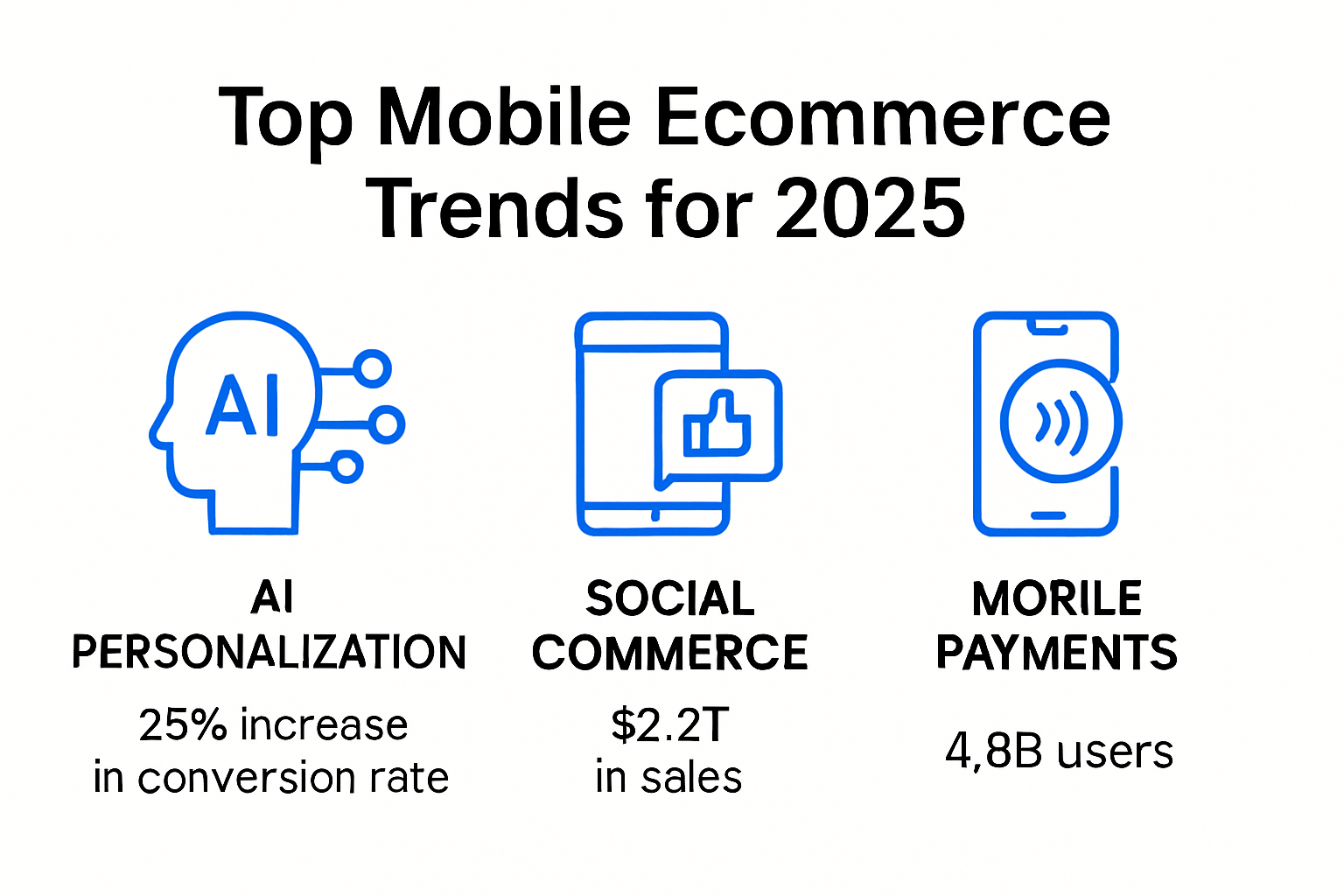Mobile Ecommerce Trends 2025: What Businesses Need to Know
Mobile shopping is taking over faster than anyone saw coming. By 2025, mobile devices are set to handle over 60 percent of all e-commerce transactions. Surprised? Most people think social media scrolling or fancy AI tools are the story. Actually, the real game-plan is much deeper. The smartest businesses are turning smartphones into personalized storefronts and treating every swipe as a golden opportunity to connect, sell, and grow in ways desktop shopping never could.
Table of Contents
- Key Mobile Ecommerce Trends Shaping 2025
- AI Powered Personalization And Customer Experience
- Social Commerce And Mobile Integration
- Mobile Payment And Technological Convergence
- Building Better User Experiences On Mobile
- Designing Intuitive Mobile Interfaces
- Augmented Reality And Immersive Experiences
- Intelligent Personalization Through AI
- Optimizing Mobile Payments And Security
- Emerging Payment Infrastructure Developments
- Advanced Security Protocols And Threat Mitigation
- User Experience And Trust In Mobile Payments
- How Businesses Can Adapt And Grow
- Strategic Digital Transformation
- Building Consumer Trust And Technological Adoption
- Navigating Market Complexity And Resilience
Quick Summary
| Takeaway | Explanation |
|---|---|
| AI-Powered Personalization is Essential | Businesses should leverage AI to create hyper-personalized shopping experiences, predicting customer needs and enhancing conversion rates through tailored recommendations. |
| Social Commerce Integration is Key | Brands must integrate shopping capabilities within social media platforms, utilizing features like in-app purchases to appeal to mobile users who view these platforms as shopping destinations. |
| Prioritizing Mobile Payment Security and Convenience | Developing secure and user-friendly mobile payment systems, incorporating biometric authentication and multiple payment options, is critical for capturing the growing market of mobile transactions. |
| Focus on Intuitive Mobile User Experiences | An intuitive design with clean navigation and responsive interfaces is essential for retaining users and converting them from browsers to buyers. |
| Adopt a Holistic Digital Transformation Approach | Embracing digital transformation means creating integrated ecosystems that enhance customer engagement and adaptability to market changes through advanced technologies. |
Key Mobile Ecommerce Trends Shaping 2025

AI Powered Personalization and Customer Experience
Artificial intelligence is revolutionizing mobile commerce by creating hyper-personalized shopping experiences. According to research from Gazett , 70% of major e-commerce platforms now utilize machine learning algorithms to deliver tailored product recommendations. These intelligent systems analyze user behavior, purchase history, and browsing patterns to generate remarkably accurate suggestions.
The implications are profound. Consumers now expect shopping experiences that feel custom-designed for their individual preferences. Mobile applications that leverage AI can predict customer needs, offer real-time personalized discounts, and create seamless user journeys that dramatically increase conversion rates. Smart recommendation engines can potentially boost sales by up to 35% by presenting products that precisely match user interests.
Social Commerce and Mobile Integration
Social media platforms are rapidly transforming into powerful mobile commerce channels. Research from Kozminski University reveals compelling statistics about social commerce adoption. Specifically, 55% of Gen Z consumers now make purchases directly through Instagram, while 51% utilize TikTok as a shopping destination.
This trend represents a fundamental shift in how consumers discover and purchase products. Mobile users no longer view social platforms as mere communication tools but as integrated shopping experiences. Brands that successfully blend engaging content with seamless purchasing capabilities will gain significant competitive advantages. Features like in-app purchasing, shoppable posts, and live shopping events are becoming standard expectations rather than novel innovations.
Mobile Payment and Technological Convergence
The future of mobile ecommerce is intrinsically linked to payment technology evolution. Cross Border Magazine indicates that mobile devices are projected to account for over 60% of all e-commerce transactions by 2025. This projection underscores the critical importance of developing robust, secure, and user-friendly mobile payment infrastructures.
Advanced technologies like biometric authentication, digital wallets, and one-click payment systems are eliminating traditional friction points in mobile transactions. Consumers now demand payment processes that are not just secure but also incredibly convenient. Businesses that offer multiple payment options, including cryptocurrency and mobile-specific payment methods, will be better positioned to capture emerging market segments.
The mobile ecommerce landscape of 2025 will be defined by intelligent personalization, social commerce integration, and frictionless technological experiences. Businesses must view mobile platforms not as supplementary channels but as primary customer engagement environments. Success will belong to those who can create mobile experiences that are not just transactional but genuinely compelling and user-centric.
To help compare the key trends shaping mobile ecommerce in 2025, the following table summarizes each major trend and its business impact:
| Trend | Description | Impact on Businesses |
|---|---|---|
| AI Personalization | AI creates hyper-personalized shopping experiences and recommendations | Increases conversion rates, predicts customer needs |
| Social Commerce Integration | Shopping directly via social media platforms (e.g., Instagram, TikTok) | Expands sales channels, engages Gen Z and mobile-first customers |
| Seamless Mobile Payments | Mobile devices, digital wallets, biometric authentication streamline transactions | Boosts transaction volume, improves user satisfaction |
| Augmented Reality Experiences | AR/VR enables product visualization in real-world settings | Reduces purchase uncertainty, raises confidence and reduces returns |
| Intuitive Mobile Interfaces | Clean, touch-friendly, responsive designs cater to mobile behavior | Enhances engagement and retention |
Building Better User Experiences on Mobile
Mobile user experience has become the critical differentiator in the competitive world of digital commerce. As consumers increasingly rely on smartphones for shopping, businesses must prioritize creating intuitive, engaging, and seamless mobile interfaces that not only attract users but also retain their attention and convert browsing into purchasing.
Designing Intuitive Mobile Interfaces
Research from ArXiv reveals that prioritizing intuitive navigation, appealing visuals, and performance optimization significantly enhances user satisfaction, leading to higher engagement and improved retention rates. The key lies in understanding that mobile users have fundamentally different interaction patterns compared to desktop users.
Successful mobile interfaces minimize cognitive load by implementing clean, minimalist designs with clear hierarchies and touch-friendly elements. This means larger buttons, simplified menus, and strategically placed call-to-action elements that guide users effortlessly through their shopping journey. Responsive design is no longer optional but a fundamental requirement, ensuring that the user interface adapts seamlessly across different device sizes and screen resolutions.

Augmented Reality and Immersive Experiences
Research from PrestaShop highlights the transformative potential of Augmented Reality (AR) and Virtual Reality (VR) technologies in mobile commerce. These technologies allow customers to visualize products in their personal environment, dramatically reducing purchasing uncertainty and improving consumer confidence.
Imagine a furniture shopping app where users can place virtual sofas in their living room, or a clothing retailer enabling customers to see how garments look on their own body without physically trying them on. Such immersive experiences bridge the gap between online and offline shopping, providing a level of interaction that traditional e-commerce platforms cannot match. The result is not just improved user experience but potentially higher conversion rates and reduced product return rates.
Intelligent Personalization through AI
Cutting-edge research from ArXiv demonstrates how Artificial Intelligence is revolutionizing mobile user experiences. By integrating AI-driven personalization, mobile e-commerce platforms can provide tailored product recommendations, efficient customer service through intelligent chatbots, and predictive user journey mapping.
These AI systems analyze user behavior in real-time, understanding individual preferences, browsing patterns, and purchase history. The result is a dynamically personalized shopping experience where product suggestions feel less like generic recommendations and more like intuitive assistance. Advanced machine learning algorithms can predict user needs, offer contextually relevant promotions, and create a sense of individual attention that significantly enhances user satisfaction.
Building better mobile user experiences is not about implementing isolated technological solutions but creating holistic, user-centric digital environments. Successful businesses will view their mobile platforms as more than transactional spaces – they will be interactive, intelligent ecosystems that understand, anticipate, and delight users at every touchpoint. The future of mobile commerce belongs to those who can transform digital interactions from mere transactions into meaningful, personalized experiences.
Below is a table detailing the key technologies driving mobile user experience improvements, along with their main benefits:
| Technology | Main Benefit | Example Use Case |
|---|---|---|
| AI Personalization | Tailored recommendations, efficient service | Dynamic product suggestions, smart chatbots |
| Augmented Reality (AR) | Increased confidence, reduced returns | Virtual try-ons, in-home product visualization |
| Responsive Design | Consistent experience across all devices | Interfaces adapting to various screen sizes |
| Minimalist UI | Reduced friction, improved navigation | Clean layouts, touch-friendly buttons |
Optimizing Mobile Payments and Security
Mobile payment technologies are rapidly evolving, presenting both unprecedented opportunities and complex security challenges for businesses and consumers. As digital transactions become increasingly integrated into everyday life, understanding and implementing robust payment security mechanisms has become crucial for maintaining user trust and protecting financial ecosystems.
Emerging Payment Infrastructure Developments
European Commission research indicates that 24% of businesses are now conducting e-sales through websites and mobile applications. This trend underscores the critical importance of developing secure, efficient payment infrastructures that can handle diverse transaction types and user expectations.
The emergence of new payment platforms like the European Payments Initiative’s Wero represents a strategic move towards reducing dependence on non-European payment providers. Such initiatives aim to create more localized, controlled payment ecosystems that offer enhanced security and greater economic sovereignty.
Advanced Security Protocols and Threat Mitigation
Cutting-edge research from ArXiv has identified seven critical attack vectors in EMV contactless payment systems, revealing vulnerabilities in application selection, cardholder authentication, and transaction authorization. These findings highlight the continuous arms race between payment technology developers and potential cybersecurity threats.
Modern mobile payment security strategies now incorporate multi-layered protection mechanisms. Biometric authentication, such as fingerprint and facial recognition, provides an additional security tier beyond traditional password systems. Machine learning algorithms can detect anomalous transaction patterns in real-time, flagging potentially fraudulent activities before they can cause significant damage.
User Experience and Trust in Mobile Payments
Securing mobile payments is not just about implementing technical safeguards but also about cultivating user confidence. Transparent communication about security measures, clear privacy policies, and immediate fraud detection and resolution mechanisms are essential for maintaining user trust.
Businesses must invest in creating seamless, frictionless payment experiences that do not compromise security. This means developing intuitive interfaces that make complex security protocols feel effortless and unobtrusive to the end-user. Two-factor authentication, tokenization of payment credentials, and instant transaction notifications are now becoming standard expectations rather than premium features.
The future of mobile payments lies in creating intelligent, adaptive security ecosystems that can dynamically respond to emerging threats while providing smooth, user-friendly transaction experiences. As technologies like blockchain, artificial intelligence, and advanced encryption continue to mature, mobile payment systems will become increasingly sophisticated, secure, and user-centric.
Navigating this complex landscape requires a holistic approach that balances technological innovation, rigorous security protocols, and a deep understanding of user behavior and expectations. Businesses that can successfully integrate these elements will be well-positioned to thrive in the rapidly evolving mobile commerce environment.
How Businesses Can Adapt and Grow
The mobile ecommerce landscape is undergoing unprecedented transformation, demanding that businesses reimagine their digital strategies to remain competitive and relevant. Successful adaptation requires a holistic approach that integrates technological innovation, customer-centric design, and strategic foresight.
Strategic Digital Transformation
Research from MDPI highlights the remarkable growth potential in digital markets, with countries like Romania experiencing a 38.4% increase in e-commerce market value between 2019 and 2020. This demonstrates that businesses willing to invest in digital infrastructure can unlock significant growth opportunities.
Digital transformation is not merely about implementing new technologies but creating integrated ecosystems that seamlessly connect various touchpoints. This means developing robust mobile platforms that offer consistent experiences across devices, integrating advanced analytics to understand customer behavior, and creating flexible infrastructure that can quickly adapt to emerging technological trends.
Building Consumer Trust and Technological Adoption
Cutting-edge research from ArXiv reveals that consumer trust and perceived usefulness are critical factors in technology adoption. Businesses must focus on transparently demonstrating the practical benefits of new technologies like artificial intelligence and augmented reality.
This involves several strategic approaches. First, businesses should provide clear value propositions that explain how new technologies directly benefit the customer. Second, implement robust data protection measures that reassure users about their privacy and security. Third, offer intuitive interfaces that make advanced technological features feel accessible and user-friendly.
Navigating Market Complexity and Resilience
Vilnius Tech Journals emphasize how digital transformation can reduce economic disparities and enhance market inclusivity, particularly in emerging economic regions. This suggests that businesses should view technological adaptation not just as a competitive strategy but as a means of creating more equitable economic opportunities.
Resilient businesses will develop agile technological infrastructures that can quickly pivot in response to market changes. This means investing in modular technological systems, maintaining a culture of continuous learning, and staying attuned to emerging consumer preferences. Machine learning algorithms, predictive analytics, and flexible cloud-based platforms will be crucial in enabling this adaptability.
The future of mobile ecommerce belongs to businesses that can balance technological sophistication with genuine human-centric design. Success will come to those who view digital transformation not as a technical challenge but as an opportunity to create more meaningful, personalized customer experiences. By embracing continuous innovation, maintaining transparency, and prioritizing user needs, businesses can not just survive but thrive in the rapidly evolving digital marketplace.
Frequently Asked Questions
What are the key mobile ecommerce trends to watch for in 2025?
By 2025, key trends include AI-powered personalization, integration of social commerce within mobile platforms, advancements in mobile payment technologies, and the use of augmented reality to enhance user experiences.
How is artificial intelligence changing mobile commerce?
Artificial intelligence is transforming mobile commerce by delivering hyper-personalized shopping experiences. It analyzes user behavior to provide tailored product recommendations, which can significantly increase conversion rates.
What role does social commerce play in mobile ecommerce?
Social commerce is becoming essential for mobile ecommerce as platforms like Instagram and TikTok enable users to shop directly through their apps. This integration allows brands to reach consumers in a space where they already spend a lot of time.
How can businesses optimize mobile payment security and user experience?
Businesses can enhance mobile payment security by implementing advanced technologies such as biometric authentication and creating user-friendly interfaces that streamline the payment process, thereby building consumer trust and improving satisfaction.
Ready to Lead in Mobile Ecommerce for 2025?
Are you struggling to keep pace with rapid mobile ecommerce changes? The article highlights how businesses must deliver personalized, intuitive mobile experiences, embrace social commerce, and create frictionless payment journeys to compete in 2025. Many companies are facing complex challenges turning these trends into actionable digital solutions. Missing out on seamless interfaces and smart integrations can cause you to fall behind in customer engagement and conversions. Your business deserves a partner who can help you master AI-driven personalization, secure mobile payments, and engaging web design that converts.

Take the next step with TRAVLRD , the digital development agency trusted by brands ready to evolve. Explore how our custom web and mobile application development services help you address every pain point discussed in the article—from social commerce integration to scalable payment technology. Visit our site today for a free consultation and get your business ready for the future of mobile ecommerce.







